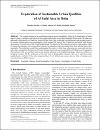The urban fabric of Al Zubarah city: Unveiling an urban regeneration vision for modern urbanism in Qatar
Abstract
The urban fabric of Islamic cities has been shaped by the rules of Sharia, sociocultural and economic factors. After being founded in the 1760s by a Kuwaiti tribe known as Utub, Al Zubarah became a flourishing pearl fishing and trading settlement. Due to its abandonment in the early 1900s, remaining untouched since then and protected by a layer of sand, the urban fabric of the city is completely preserved. This research study explores the urban layout of Al Zubarah city, analysing the evolution of its urban fabric, network, access, functions and main land uses, influenced by the sociocultural factors that contributed to its formation. The paper includes a review of the literature and exploratory interviews with academics, urban planners, archaeologists and historians. It also provides a site layout analysis of the urban fabric of the archaeological site based on the design principles and morphological components of Islamic cities. The analysis is based on the methodological approach conceived by Petruccioli, who analyses the Islamic city on three different scales: 1) the urban organism; 2) the urban fabric; and 3) the building type. The findings reveal that the urban fabric of Al Zubarah has been influenced by sociocultural factors. The relationship is visible through the urban fabric, network and types of building within the site. The outcome of this research study reveals how one of the most important UNESCO World Heritage Sites in the State of Qatar is the manifestation of urban design principles, which should contribute to the urban regeneration and renewal of modern Islamic cities.
DOI/handle
http://hdl.handle.net/10576/11538Collections
- Architecture & Urban Planning [308 items ]
Related items
Showing items related by title, author, creator and subject.
-
An integrated design strategy for the urban regeneration of west bay, business district of Doha (State of Qatar)
Al-Thani, Sarah M.; Furlan, Raffaello ( MDPI , 2020 , Article)Emergent communities have integrated land use and transportation plan based on transit-oriented developments (TODs) and light rail transit with the sole purpose to enliven and redevelop the constructed environment. Doha ... -
Mitigation of urban voids in traditional neighborhoods: The case of the Al-Najada zone in Doha, Qatar
Asmaa Saleh, AL-Mohannadi; AL-Mohannadi, Mooza Saqr; Pokharel, Shaligram; Ayari, Mohamed Arselene; Furlan, Raffaello ( Elsevier , 2023 , Article)Urban voids and leftover spaces challenge the urban development of cities and result in land vacancy and other spatial planning issues. Such spaces have great potential for innovative intervention through piece-by-piece ... -
Exploration of Sustainable Urban Qualities of Al Sadd Area in Doha
Eiraibe, Nussyba; AL-Malki, ALMaha Ahmed; Furlan, Raffaello ( Scientific & Academic Publishing , 2016 , Article)This research focuses on the contributions made to social sustainability, firstly by the functionality of urban spaces in Qatar, as defined by their physical form, and secondly by the socio-cultural attributes of those ...




